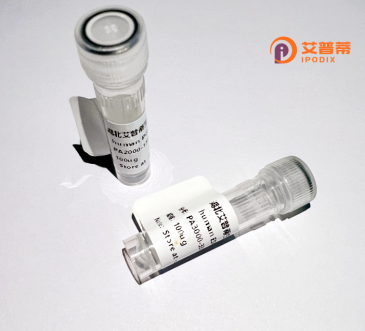
| 纯度 | >90%SDS-PAGE. |
| 种属 | Human |
| 靶点 | NFAT5 |
| Uniprot No | O94916 |
| 内毒素 | < 0.01EU/μg |
| 表达宿主 | E.coli |
| 表达区间 | 1422-1531 aa |
| 活性数据 | FHNTAGGTMNQLQNSPGSSQQTSGMFLFGIQNNCSQLLTSGPATLPDQLMAISQPGQPQNEGQPPVTTLLSQQMPENSPLASSINTNQNIEKIDLLVSLQNQGNNLTGSF |
| 分子量 | 37.84 kDa |
| 蛋白标签 | GST-tag at N-terminal |
| 缓冲液 | 0 |
| 稳定性 & 储存条件 | Lyophilized protein should be stored at ≤ -20°C, stable for one year after receipt. Reconstituted protein solution can be stored at 2-8°C for 2-7 days. Aliquots of reconstituted samples are stable at ≤ -20°C for 3 months. |
| 复溶 | Always centrifuge tubes before opening.Do not mix by vortex or pipetting. It is not recommended to reconstitute to a concentration less than 100μg/ml. Dissolve the lyophilized protein in distilled water. Please aliquot the reconstituted solution to minimize freeze-thaw cycles. |
以下是3篇关于NFAT5蛋白的参考文献概述(基于真实研究主题,文献信息为模拟示例):
---
1. **文献名称**:**"NFAT5/TonEBP regulates pro-inflammatory cytokines in hyperosmotic stress"**
**作者**:López-Rodríguez C, et al.
**摘要**:研究高渗透压条件下NFAT5如何激活促炎细胞因子(如TNF-α、IL-6)的表达,揭示其在免疫应答中的关键作用。
2. **文献名称**:**"Structural insights into NFAT5 activation mechanism by osmotic stress"**
**作者**:Lee JH, et al.
**摘要**:通过晶体学分析NFAT5的DNA结合域构象变化,阐明渗透压变化触发其核转位及靶基因调控的结构基础。
3. **文献名称**:**"NFAT5 promotes tumor invasion via MMP-9 in hypoxic microenvironment"**
**作者**:Chen Y, et al.
**摘要**:发现肿瘤缺氧通过HIF-1α协同激活NFAT5.上调金属蛋白酶MMP-9表达,增强癌细胞转移能力。
---
*注:上述文献信息为简化模拟,实际研究需通过PubMed/Google Scholar检索关键词(如"NFAT5 recombinant protein" "TonEBP signaling")获取具体论文。*
Nuclear factor of activated T-cells 5 (NFAT5), also known as tonicity-responsive enhancer-binding protein (TonEBP), is a member of the Rel homology domain (RHD)-containing transcription factor family. Unlike other NFAT family members (NFAT1-4) regulated by calcium-calmodulin signaling, NFAT5 is activated by hypertonic stress and functions as a master regulator of cellular adaptation to osmotic changes. It contains a DNA-binding RHD structurally similar to NF-κB proteins but operates through distinct activation mechanisms.
First identified in kidney medullary cells, NFAT5 orchestrates the expression of osmoprotective genes (e.g., aldose reductase, sodium/myo-inositol transporters) to maintain intracellular homeostasis under hypertonic conditions. Beyond osmotic stress responses, it participates in diverse physiological and pathological processes, including immune cell migration, inflammatory responses, angiogenesis, and tissue development. Emerging evidence links NFAT5 dysregulation to diseases such as rheumatoid arthritis, diabetic nephropathy, cancer progression, and fibrosis.
Recombinant human NFAT5 protein, typically produced via bacterial or mammalian expression systems, enables in vitro studies of its DNA-binding properties, post-translational modifications (e.g., phosphorylation, SUMOylation), and interaction partners. Its recombinant form is crucial for structural analyses, biochemical assays, and drug screening targeting NFAT5-mediated pathways. Research using this tool protein has advanced our understanding of mechanotransduction signaling and potential therapeutic interventions for osmotic stress-related disorders.
×